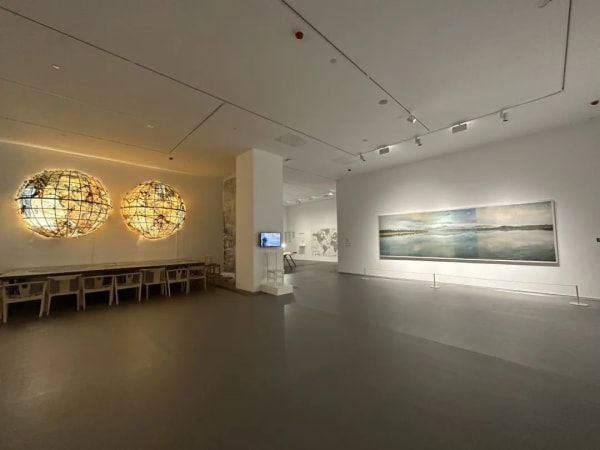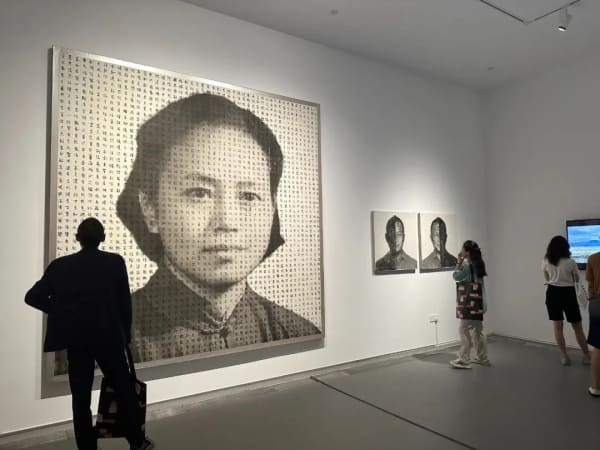2023 Parallel Exhibition of Chengdu Biennale-Geographies of Feeling
Curators: Dr. Sophia Kidd, Li Jie
Coordinators: Huang Xiaorong, Zhang Yi
Duration: Aug 19, 2023 - Nov 19, 2023
Exhibition Venue: A4 Art Museum NO.3 Exhibition Hall
Building 21, No. 18, Section 2, Lushan Avenue, Wanan Street, Tianfu NewDistrict, Chengdu, China.
'Affective geography' belongs to a larger emerging field of 'creative geography' which asserts that works of art articulate various aspects of human spatiality, not just one feature having to do with space or place but several such dimensions. One important innovation in this exhibition is its geographical approach to examining three influential artists in Chinese contemporary art development. To this end we have selected three artists, Zhu Cheng, He Gong, and Dai Guangyu, all born in Southwest China before China's '85 New Wave contemporary art movement. While the selection of three older generation artists is essential in looking backwards, we have also invited these three to select younger generation artists whose artworks create dialogue between generations. These seven artists include Hu Jiayi, Pu Yingwei, Tong Wenmin, Wang Zifan, Wang Yanxin, Wang Zheng, and Zhu Ming.
Another important innovation in this exhibition is its geographical approach to critical issues such as cultural identity and cultural diaspora. To explore relationships these ten artists have with local art ecosystem of Sichuan and Chongqing areas, we look at three fundamental geographical dimensions of their works in this exhibition: physical geography, cultural geography, and geographies of feeling. These three dimensions are not separate from one another and are indeed difficult to discuss as isolated elements of our phenomenal or inner worlds. However, some works can be discussed more easily in terms of their physical, cultural, or affective elements, and we hope that this approach helps viewers to develop a closer relationship with the artworks and poetry in this exhibition.
Physical Geography
In the Documentation section of this exhibition, we display a map of the world. We asked each of this exhibition's ten participating artists to place coordinates on these maps to indicate where they have lived, studied, worked, created artworks, joined exhibitions, or participated in artist residencies. We then invite audiences to interact with the map, by placing on it coordinates of their own life's path.
The places and spaces that artists pass through influence their mood, feelings, senses, perception, and cognition. An artist's social milieu, life story, as well as the books they've read or studied, all go into forming the artist's affective field of being, which in turn determines many, if not all, elements of an artist's creative practice. Thus, each place an artist dwells within or passes through provides a new habitus or social context in conjunction with a cultural trajectory that expresses itself within the artist's creative output. This focus upon the physical geography of an artist's creative output is just the first of three geographical dimensions we examine in this exhibition.
Cultural Geography
Next, we look at the second geographical dimension of works in this exhibition-cultural geography. We see cultural geography as valent to human geography, and whereas our first geographical dimension of concern, physical geography, was purely concerned with space, this second dimension is not only concerned with synchronic studies of space but is also interested in the diachronic developments of situated cultures through time. An important similarity between physical and cultural geography is that they are both materially based fields of awareness. That is, these fields of knowledge are objectively situated in the materially based world. Physical geography studies the physical places and spaces that individuals and groups move through, while cultural geography studies the languages, customs, discourses, knowledge, economies, governments, and education that arise in interactions between individuals and groups of people. Culture is something that can only be studied in the context of a passage of time, by comparing one moment of interaction to another, and is thus fundamentally historical in nature. With this in mind, we look at the historical dimensions of artworks in this exhibition.
Affective Geography
The third primary dimension in this exhibition dwells on the notion of affective geography in Geographies of Feeling. Whereas our first two primary dimensions address space and time, respectively; our third dimension takes us inwards, into both the artworks and ourselves. These artworks embody intersections of places, times, and feelings. Feelings interact with society, culture, and times, while artworks interact with viewer's feelings. Art and literature are wonderful ways in which to articulate something so elusive and nebulous as emotion.
Distinction between Affect and Emotion
Affect includes reason, emotion, and all somatic sensibilities. It includes sensibilities felt upon entering a new space, comprised of all our perceptions, such as of wall color, height of a ceiling, material of floorboards, air temperature, sound of music or construction nearby, as well as presence or absence of people. However, It also includes an awareness or memory of all similar or different spaces. When we arrive at our hometown after a vacation or long departure, our body remembers every other arrival and return to this place, and our affective experience of our hometown is then a mosaic of all these moments, all existing within our mind, heart, and body.
Emotion is that which society has succeeded in characterizing within psychological discourse. These emotions include such feelings as happiness, sadness, joy, disappointment, love, anger, confidence, and frustration.
Emotion is a simplification of affect, a convenient way to deal with the overwhelming modes of affect which influence our daily lives from the moment we awaken in the morning to the moments of navigating our dreamscape later that night. Emotion helps us to name and deal with the complexities of affect.
Discussion of Ecology in Affect Geography
We shall examine these emotions through the lens of material, medium, and methodology; relying on these concrete, measurable, and discursive elements to study and describe artworks in this exhibition. Structuralism, formalism, genre & mode are instruments which lead to breaking open paradigms and offering new & substantive vision by which to view our outer and inner worlds. However, these structuralist, formalist, genre-based examinations of material, mode, and methodology have their limitations. To merely address the formalist and methodological properties of artworks is to occlude the inner worlds of those who create artworks, be them artists or viewers of artworks who, after all, participate in the creative process of artwork through interacting with it. Formalist analysis of artworks must extend further into critical reflection and social praxis, by articulating the experience of place felt by poet and artist, by exploring physical, cultural, and affective geographical dimensions expressed within a work. Poetry and art live within the nature of our being, and every being is by nature an ecosystem, existing within ever greater ecosystems. This ecological approach to art explores and values individuality within the context of interconnectedness. Examining how physical, cultural, and affective geographies interconnect may give us a more integrated understanding of the world and our place in it.
August 15, 2023





